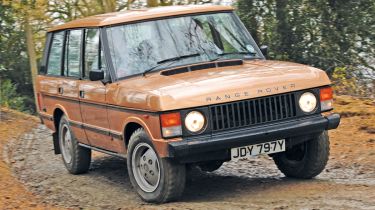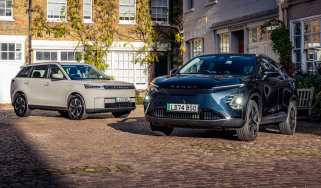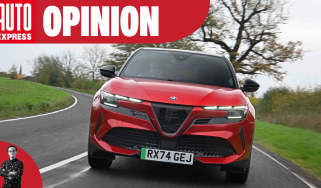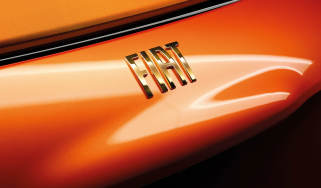Range Rover Mk1
Behind wheel of car that kick-started luxury 4x4 phenomenon four decades ago
The Range Rover is a British motoring icon that’s famed across the world for its combination of space, luxury and off-road ability. And more than 40 years after it arrived, it’s still the benchmark in luxury 4x4 motoring.
Yet when the Range Rover made its debut in 1970, 4x4 vehicles were workhorses, without the slightest nod to comfort, refinement or performance. Rover engineering chief Charles Spencer King was looking to change all that: he wanted to pursue the idea of a vehicle that combined the comfort and on-road handling of a Rover saloon with the off-road ability of a Land Rover.
Rover staff had already visited the US to look at cars such as the Jeep Wagoneer and Ford Bronco, which offered some ability in the rough stuff and passable handling on tarmac. However, the new Range Rover would be far more than a clone of an American station wagon.
Work on prototypes began in 1966, and the finished car was shown to the media in June 1970. As with the Land Rover it had a ladder-frame chassis, while under the bonnet Rover’s familiar Buick-based 3.5-litre V8 was matched to permanent all-wheel drive and a four-speed manual transmission, complete with low and high-ratio drive and a locking differential.
Used - available now

2020 Land Rover
Range Rover
66,000 milesAutomaticDiesel3.0L
Cash £36,990
2023 Land Rover
Range Rover
26,000 milesAutomaticPetrol3.0L
Cash £90,000
2017 Land Rover
Range Rover
56,000 milesAutomaticDiesel3.0L
Cash £25,950
2021 Land Rover
Range Rover
65,912 milesAutomaticPetrol2.0L
Cash £29,337The coil-spring suspension had double the articulation of a Land Rover’s set-up, meaning the Range Rover’s cross-country comfort and off-road prowess were unrivalled. Yet the car’s elevation to luxury status was still a little way off. For instance, the simple, three-door, aluminium-clad body was a case of form following function. Flat sides, thin roof pillars and short overhangs gave the Range Rover a practical yet instantly recognisable shape, while the austere cabin had washable vinyl seats and rubber flooring.
The only nod to luxury was the small amount of carpet wrapped around the transmission tunnel, which helped dampen gearbox whine on the move. In fact, it wasn’t until the early eighties that the Range Rover began its relentless climb upmarket.
Inspired by a car loaned to Vogue magazine for a fashion shoot in 1981, Land Rover created a limited run of ‘In Vogue’ three-door models that offered smarter cabins and special paint finishes. A year later, this range-topping model was joined by a five-door version, while a three-speed automatic gearbox became an option.
The car in our pictures was delivered new in 1982 and cost £16,700. The cabin featured headrests, armrests, a four-speaker stereo, a coin tray and full carpeting.
Alloy wheels and air-conditioning were standard, too, while you could even specify a plush picnic set. Driven today, it’s clear this Vogue model was still considered a utility vehicle at that time. The basic dash, toggle switches and spindly steering wheel are a world away from today’s luxurious Range Rover. The petrol V8 chugs away at idle, but once on the move, with only three forward gears in the auto box, revs are surprisingly high at gentle speeds. Early cars didn’t have power-steering, but the light assistance of our early eighties Vogue makes things a bit easier – although you still need plenty of input to turn a corner.
For all that, the relaxed driving experience, ease of use and lofty view of the road would be strangely familiar to an owner of a modern Range Rover – hardly surprising, given that this car’s imperious personality has changed little through the years. Incredibly, despite troublesome reliability and dubious quality, the original – eventually and respectfully called the Classic – remained on sale for more than 25 years. A raft of updates and improvements kept customers happy well into the car’s old age. The V8 grew to 3.9 and then 4.2 litres, injection replaced carbs, a ZF four-speed auto superseded the outdated three-speeder, while an unrefined Italian VM diesel brought a much-needed reduction in fuel consumption in 1985.
Despite its dated origins, in the last years of its life the Classic was the first 4x4 to have ABS, electronic traction control and electronic air-suspension. But time caught up and, after being sold alongside the second generation for two years, production of the Classic stopped in 1996, with 317,615 examples having found homes around the globe.
Not bad for a car that, during its infancy back in the seventies, several Rover executives believed had no future. They couldn’t have been more wrong...



